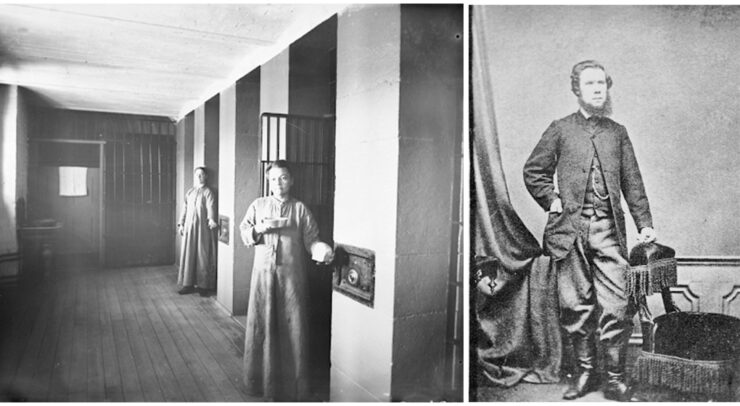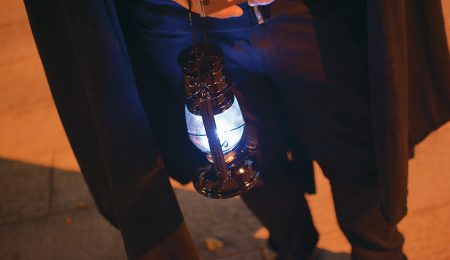A look into the captivating ghost tours in Ottawa
The Carleton County Gaol opened in 1862 and was shut down in 1972 due to its inhumane conditions. And in the following year, Hostelling International reopened the jail as a hostel. Since then, guests from all over the world pay to sleep in tiny cells that inmates were once forced to serve time. The old jail is also an Ottawa Heritage Site where tourists follow historical and ghost tours.
On Oct. 11, I took the Haunted Ghost Tour at the Carleton County Gaol. My tour guide spoke in a booming voice. And after each story, he whipped his cape around and beckoned us to follow the glow of his battery-powered lantern. The guide told ghost stories and shared information about the prison’s history. But mostly, he spoke about Patrick James Whelan.
Whelan was charged and executed on account of Thomas D’Arcy McGee’s murder. Whelan was a member of the Fenian Brotherhood; a group of veterans who wanted to invade and capture the British North American colonies in exchange for Ireland’s independence.
The Fenians considered McGee an Irish traitor (due to McGee’s support of Confederation), so the court assumed Whelan murdered McGee due to his association with the group.
Whelan was hanged on February 11, 1869, and, according to the tour guide, was buried in an unmarked grave in the jail’s courtyard, which was an affront to his desire for a proper Catholic burial.
At the end of the tour, the guide pointed to the rock under which Whelan’s body is possibly buried and said, “never taunt Whelan or else your nose will bleed.”
He explained that a group of school children once jumped on Whelan’s grave and chanted his name; consequently, the children’s noses bled. Despite this strange event, people come to the prison with their pockets stuffed with tissues, prepared for a spirit-induced nose bleed, and happy to pay a $30 admission fee.
What is dark tourism?
But why are so many people spending money on such an experience? First, we should ask why tourists are fascinated by the Carleton County Gaol and the entirety of dark tourism.
As explained by Kevin Walby, associate professor at the University of Winnipeg and Justin Piché, assistant professor at Memorial University of Newfoundland, dark tourism can affect our perception of life in jail.
Together, their paper The Polysemy of Punishment Memorialization: Dark Tourism and Ontario’s Penal History Museums argues that dark tourism involves a, “[visit to] sites associated with death, disaster and tragedy for remembrance, education, or entertainment.”
Greg Brockmann, the general manager of the Ottawa Jail Hostel (Carleton County Gaol), explained that the hostel offers a daily prison tour for guests.
The hostel’s team regularly, “researches crimes committed by past inmates, [shares the stories] and reports about the people who were arrested,” explained Brockmann.
The twisted tales and human tragedy associated with the jail fascinate tourists.
My tour guide told a story about inmates who revolted against the guards in an attempt to escape. While I was greatly interested in this story, I was also disturbed by my interest in the prisoners’ desperate struggle to leave their captive confines.
Brockmann believes that we like dark tourism for the same reasons we like to observe car wrecks on highways.
“It’s strange — the jail was closed-down because of terrible living conditions in 1972,” he said. “And then, less than a year later, the city reopened it as a hostel.”
Years later, guests stay at the hostel to live through an ‘authentic’ jailer’s experience.
What is the point of dark tourism?
Creative director of the Haunted Walk of Ottawa, Jim Dean, has a similar theory for why people enjoy tours of the prison.
“People like to hypothesize about unsolved mysteries,” he said.
And the jail, in particular, is interesting because it’s unassuming.
“Think about all the people whose daily commute passes the jail,” said Dean. “And think about how many of those people don’t know the jail’s history.”
In his haunted walk, Dean includes “historical ghost stories” in the tour’s script to enhance a visitor’s experience.
“Dark tourism is an industry where it is easy to lose credibility, historical accuracy matters. It matters so much that we write ‘historical ghost stories.’ ” he said.
As a result, Dean says that his team writes ghost stories according to reports of supernatural activity in the jail. His team then links the supernatural events to a historical truth.
For example, it is true that Whelan is buried on the jail’s property and it is also true that individuals frequently get nosebleeds when they pass Whelan’s unmarked grave. While these two truths don’t necessarily relate, once paired, they make a great story and enhance the experience.
Dean says that a ghost comes to life when a listener’s imagination lends credence to the guide’s stories. And in a way, Whelan’s ‘ghost’ engages with the tourists’ imagination through the threat of temporary harm.
In their study, Walby and Piché say that dark tourism is guilty of “[making] light of what prison living is like.” However, these are not the intentions of either Brockmann or Dean. Both facilitators think it is important to preserve the history of the jail and encourage people to visit.
“Many of my colleagues majored in history. And we all internalize [the famous line from philosopher, George Santayana]: “Those who cannot remember the past are condemned to repeat it,” said Dean.
While the erie-ness of the ghost tour brings a profit, Brockmann and Dean expressed their worry about the state of living conditions in modern-day penitentiaries.
“While Canadians have made progress with how we treat our prisoners since the nineteenth century, we still have a lot of work to do,” said Brockmann.
In 2019, jail guards at the Ottawa-Carleton Detention Centre failed to cater to the needs of a suicidal inmate. That same jail is overcrowded, which means inmates sometimes have to ‘double-bunk’ in showers which are repurposed as cells. In particular, the conditions have led to the Government of Ontario to plan the opening of a more spacious jail in Ottawa.
Still, finding ways to make the tour experience as daunting yet realistic as possible is key to the effectiveness and success of the local dark tourism attraction.
“It is my team’s job to explain what life was like for prisoners at the Carleton County Gaol,” said Dean. “For a tourist to truly experience what the prison was like when it held prisoners, his team would have to simulate the smell of human excrement, the sound of guttural cries, and a constant threat of violence.”
“It doesn’t matter how much time I spend at the jail. Because I am aware of its history, I still get scared when inside.”



